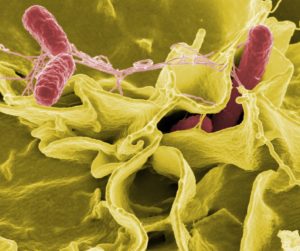 What is a “Raw Food Diet?”
What is a “Raw Food Diet?”
Have you ever considered putting your dog on a raw food diet? Many people are certain that their dogs are healthier because their food never came near a cooktop–but are they right? Or, are they just believing what they want to believe? So, what is on the “raw food diet,” and why should or shouldn’t I consider feeding this to my dog?
Like the name implies, a raw food diet simply means that nothing is cooked. However, many people who use a raw food diet for their dog typically feed the following: Muscle meat, often still on the bone; Bones, either whole or ground; Organ meats such as livers and kidneys; Raw eggs; Vegetables like broccoli, spinach; Apples or other fruit; Some dairy such yogurt1.
Raw Food Diets: Myths and Facts

Although huskies may resemble wolves, their genetic make-up is markedly different.
Myth: Dogs are carnivores.
Fact: Wolves are carnivores, but dogs are not.2 Although both are in the order Carnivora, dogs gained genes during domestication that produce enzymes used to digest starches, which their wolf ancestors lacked. According to the Merck Vetrinary Manuel,3 “A recent report shows that dogs have 36 regions of the genome that differ from that of wolves, and 10 of these regions play a critical role in starch digestion and fat metabolism.”
Myth: Grains are unhealthy for dogs.
Fact: Grains are a good source of carbohydrates for most dogs. You may have been warned away from commercial dog food because it contains grains such as corn or rice. As discussed above, carbohydrates are a necessary component of a dog’s well balanced diet, and although some dogs have allergies to certain grains, most dogs tolerate grains well. Grains are not just “filler.” They are an important component of a dog’s diet.
Myth: I should feed my dog raw meat because it’s natural.
Fact: Natural does not equal healthy. In nature all wild animals, including wild wolves and ferral dogs, constantly battle disease, starvation, and death. Wild animals do not enjoy optimal health, but your dog can.
Myth: Cooking destroys natural enzymes that my dog needs for good health.
-
Bacteria Associated with Raw Food
- Salmonella spp
- Campylobacter spp
- Clostridium spp
- Escherichia coli
- Listeria monocytogenes
- enterotoxigenic Staphylococcus aureus
Fact: Your dog does not need enzymes from food for good health. Your dog, like every living organism, needs enzymes, but he or she doesn’t need to get them from raw food. Enzymes are proteins, and like all proteins, are made from amino acids. Cooking denatures (unfolds) the enzyme but does not destroy the amino acids.
If the enzymes are delivered to the stomach raw, the hydrochloric acid will also unfold the enzymes, and so have the same affect as cooking. Later in the digestive tract, protein cutting enzymes digest proteins into their constituent amino acids. The dog’s metabolism then uses the amino acids to make his or her own enzymes. As long as a dog has a balanced diet, he or she will be able to make all the enzymes needed for good health. It doesn’t matter whether the meat was raw or cooked to upon consumption.
Myth: Bones are good for dogs.
Fact: Bones can splinter and puncture organs in the digestive tract. In addition, large amounts of calcium can cause constipation and, over time, bladder stones.
Myth: I should feed my dogs raw eggs, dairy, and organ meats.
Fact: You should not regularly feed your dog raw eggs, dairy, and organ meats.
Raw Eggs contain a protein called avidin, which binds to biotin, or vitamin B7 and makes it unavailable for use by the body. Biotin deficiency can cause skin problems, hair loss, and poor growth. Note: Cooking the eggs denatures the avidin, and the eggs will no longer cause the vitamin deficiency. However, eggs should still be considered a supplemental (treat) portion of the diet, if used at all.
Dairy. Adult dogs, like most adult mammals except humans, lack the enzyme lactase that digests lactose, which is the predominant sugar in milk. Thus, it causes symptoms very similar to those lactose intolerant humans experience when consume dairy products: bloating, cramping, gas, and diarrhea. Although you would notice the third and fourth symptoms, your dog might suffer the first two chronically without you knowing he or she is in pain if you repeatedly feed dairy.
Organ Meats. Organ meats are a rich source of vitamins and minerals, and your dog may get too much of a good thing. If routinely fed organ meats, especially in large amounts, some nutrients can reach high levels . For example, your dog may get an excess of vitamin A. Organ meats are also a rich source of iron, and high levels of iron can become toxic.
Bacteria: The Big Concern
One source of disease wild animals face is through uncooked meat. Meat is contaminated with intestinal bacteria like salmonella and E. coli when processed–either by canine teeth or human machines–and that bacteria can cause disease. Worse yet, those bacteria can be spread to humans.
Even if your dog does not look sick, he or she can be a carrier of disease. In their policy on raw food diets, the American Veterinary Medical Association explains the following: “Cats and dogs can develop subclinical infections with these organisms [Salmonella spp, Campylobacter spp, Clostridium spp, Escherichia coli, Listeria monocytogenes, and enterotoxigenic Staphylococcus aureus] but still pose a risk to livestock, other nonhuman animals, and humans, especially children, older persons, and immunocompromised individuals.”4
Does this mean that you need to rush your dog to the emergency room if he eats a gopher? That probably won’t be necessary, but why expose your dog to more risk than necessary through feeding raw meat?
Keep It Simple
Due to many factors, including high levels of bacteria and the difficulty in obtaining optimum, balanced nutrition, dogs fed raw meat diets are often not as healthy as those fed commercial dry dog food. In this case, the simple solution is likely the best solution.
Works Cited
1. Raw Dog Food: Dietary Benefits, Concerns, and Risks. WebMD. Accessed 3/11/17.
2. Coppinger R, Coppinger L (2001) Dogs: a new understanding of canine origin, behavior and evolution. New York: Scribner. As cited in: Reiter T, Jagoda E, Capellini TD (2016) Dietary Variation and Evolution of Gene Copy Number among Dog Breeds. PLoS ONE 11(2): e0148899. doi:10.1371/journal.pone.0148899.
3. Dog and Cat Foods: Raw Meat-based Diets. Merck Veterinary Manuel. Accessed 3/25/2017
4. AVMA Policies: Raw or Undercooked Animal-Source in Cat and Dog Diets. American Veterinary Medical Association. Accessed 3/20/17.







